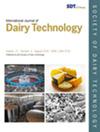Feasibility of utilising orange (Citrus sinensis) peel powder as a fat substitute in frozen yoghurt
Abstract
Background
Frozen yoghurt is a popular dairy delicacy that can be enhanced with functional ingredients. Various fruit peels are already used as fat substitute in ice cream and frozen desserts. Orange peel is a rich source of minerals, fibre and natural antioxidants, especially flavonoids.
Aim(s)
The aim of this study was to explore and utilise a fibre derived from orange peel powder as a fat replacer in frozen yoghurt. Orange peel, rich in soluble fibre, exhibits favourable technological attributes. These characteristics suggest its potential as a fat substitute in foods, along with its antioxidant properties.
Methods
Experimental frozen yoghurts were prepared using milk fat levels of 2.0%, 4.0% and 6.0% with a fixed level of 2.5% orange peel powder. A control frozen yoghurt with 6.0% milk fat without orange peel powder was also prepared. The products were analysed for composition, viscosity, titratable acidity, overrun, melting rate and sensory acceptability.
Major Findings
Varying fat levels significantly affected carbohydrates, proteins, ash, total solids content and viscosity of frozen yoghurt mixes. However, titratable acidity, overrun and melting rate were not markedly influenced. The increased milk fat content of experimental frozen yoghurt (6.0%) resulted in improved texture and stability, whereas the low-fat variant (2.0%) had a higher protein and carbohydrate content as well as melting rate. Sensory evaluation revealed that frozen yoghurt with 2.0% milk fat and 2.5% orange peel powder was the most acceptable formulation for sensory scores, particularly for flavour, body and texture, and total score, indicating improved acceptability as compared to other treatments.
Scientific or Industrial Implications
These results show that low-fat frozen yoghurt (2.0%) enriched with orange peel powder can be successfully formulated to have improved physico-chemical properties and consumer acceptability. This study provides insights for the dairy industry to develop functional frozen yoghurt products using fruit by-products.

 求助内容:
求助内容: 应助结果提醒方式:
应助结果提醒方式:


